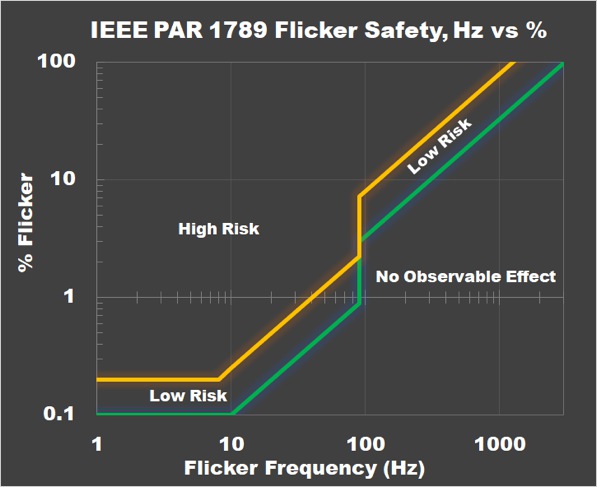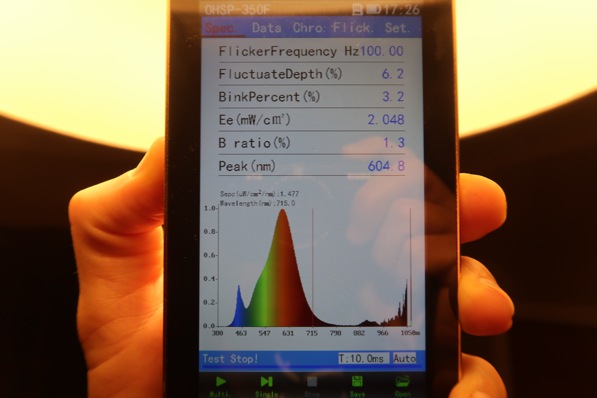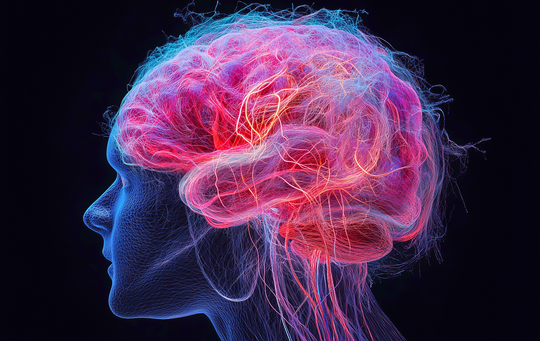In our modern world with plenty of artificial lights, digital screens, television, and videos – we are exposed to light flicker more than ever in human history!
We often hear the risks and demonization of the blue light component of artificial lights and screens, yet another important risk factor is flicker.
This risk factor is often overlooked and misunderstood, yet it carries with it many potential health hazards.
Similar to the constant ever-present exposure to artificial blue light, nnEMF, and air pollution; flicker is another invisible assailant that may threaten our health.
Often, we see the best way to biohack our environment is to simply emulate natural conditions to allow our body to perform best. Seeking lighting sources that are low or no flicker is ideal for our health and performance.
However, as we move along in this blog post, the complexity of flicker is what makes it difficult to understand, identify, and control the flicker around you.
By the end of this article, you will be well-versed in knowing what flicker is, how to spot it, avoid it, and mitigate it.
In This Article We Will Learn:
- What is flicker and why it is an issue in modern life.
- The definition of flicker.
- How to describe flicker in terms of Frequency (Hz) and Percentage (%)
- Flicker characteristics of Incandescent, Fluorescent, and LED lighting
- General human interpretation and sensitivity to flicker.
- The worst types of flicker to look out for.
- Symptoms, risks, and health hazards associated with flicker.
- Mitigation tips and avoidance methods for flicker.
Common Misconceptions About Flicker That We Will Clear Up:
- Flicker is not only characterized by frequency (Hz), but also by percent modulation of intensity (the change in intensity of the light with each 'flicker')
- Flicker can be both visible and invisible.
- Visible flicker is likely still the most hazardous form for short-term exposure.
- Incandescent lighting on AC power does flicker, but not as much as low-quality LED light.
- LED and Fluorescent can be safe for flicker if they use high-quality electronics.
- Flicker doesn’t always affect everyone the same way, but is important to look out for signs and symptoms of flicker.
Author: Andrew LaTour. Founder and Owner of GembaRed LLC.
Bachelors of Science in Chemical Engineering with career experience in processing and development of specialty materials for aerospace, automotive, semiconductor, and alternative energy industries. Andrew has been a diligent biohacker and researcher for 5 years in his personal quest to optimize his health.
Let's Begin: What Is Flicker?
Any change in brightness of a light is called “flicker.”
Flicker is a loose term defined as a “modulation of intensity” from a light source (1).
Most people might consider flicker as a full on/off situation dependent on the Frequency (Hz).
Remember the strobe lights at those parties that you used to go to? That is considered a form of flicker with fully on/off effects.
To be more precise with the term, flicker can range from a small percentage drop in intensity, to a full on/off cycle. It is important to consider this percentage modulation of intensity, not just the frequency (Hz) of the light.
How Does Flicker Affect Us?
The primary pathway for flicker is through the eyes. We rely on our eyes for nearly all activities from reading, writing, coordination, work environments, sports, and operating cars and equipment.
Now imagine when you go to a party or a concert where they are using strobe-lights for ambiance. It may look cool, and your dance moves may seem slower and distorted.
However sensitive individuals may already feel distressed from a strobe-light. Now imagine that the frequency (number of flashes per second) of the strobe light is so fast that you can barely notice it.
Your brain will work harder to stitch together this fast strobe to be perceived as a continuous light source, but motion will appear slowed down and movements will still be distorted.
This new strobe-light reality will be disorienting and confusing, especially if you are required to read or perform activities under it. Your eyes and brain will be challenged every time you change what you are focusing on.
This is an extreme example of what the flicker effect is. If we have strongly flickering lights and have to concentrate on tasks under it, then it is easy to imagine it will lower our performance and possibly cause long-term issues.

Picture 1. Normal motion blur (left) versus strobe-like phantom-array blur due to flicker (right)
Entering an environment with heavy invisible flicker could cause us to have immediate eyestrain or headache.
A student might have trouble concentrating on their work because they are reading under a flickering light or on a flickering computer monitor. An employee working under flickering light might become distracted and reduce productivity.
We might even be straining our head and neck to subconsciously avert our eyes from the flicker and avoid unnecessary eye movements. Driving at nighttime we might see taillights and headlights as a blur that our eyes cannot focus on. [3]
Children are at risk with worsening mood or irritability or more serious health responses such as seizure (1). Long term exposure to flickering environments might cause more systemic and neurological damage.
*this article will use flickering images or video to help demonstrate flicker, some safety precautions before viewing these videos include viewing them in a well-lit room, increasing distance from the screen, and covering one eye with your hand*

Above we see a number of flickering and non-flickering LED bulbs, at normal video speed.
Flicker Effects
Similar to most invisible health risks such as toxins, non-native EMF, and air pollution – flicker affects everyone differently, and the effects depend on the type and magnitude of the hazard.
The effects also depend on a person’s sensitivity to the hazard. A person with asthma (me) will react differently to air pollution than a healthy individual, similarly, a person with preexisting photosensitivity (also me) will respond differently to flicker than a healthy person.
The healthy person will not immediately feel the effects of flicker, but long-term exposure may still manifest damages or cause sensitization.
This is why flicker is an extremely subjective topic, some people whom are resilient to flicker can dismiss it as another “woo” topic, yet the people with photosensitivity to flicker are left to suffer thinking that their symptoms are made-up.
A light source may have a lot of flicker or low-flicker. It is a common misconception that incandescent light bulbs have “no flicker” while LEDs are the primary culprit of flicker issues.
This is not always the case as the flicker effect in LEDs is more complex. As LEDs become more commonplace, it is important to find “safe” LEDs rather than run away from them completely.
In fact, modern LEDs may perform better and with less flicker than incandescent bulbs. The lack of education and communication on the topic of flicker is what tends to bring about unnecessary fear.
Research on flicker effects are not a new or fringe thing. It is a well-defined phenomenon in the lighting industry with standards and studies conducted by the IEEE, CIE, DOE, UL, EPA, and several health organizations.
The challenge is that currently there are no enforced standards on flicker quality, and there are debates on how to address flicker properly in the industry.
So, we can already see why flicker has taken a back-seat when it comes to bringing it into the forefront of health topics:
- It is highly subjective to the observer.
- The effects on humans are not always obvious.
- All lighting sources have different flicker properties.
- There are no required or enforced standards for flicker in lighting.
- Lack of education on the topic of flicker.
The good news is that we have a large body of resources and research to draw upon for reasonable discussion. So be sure to follow up with the citations and references, as they also contain a wealth of additional details on this topic.
Before we discuss the health hazards and human effects of flicker, we must first clearly define and understand flicker.
Where Does Flicker Come From And Why Is It In Modern Lights?
Flicker is present in nearly all Alternating Current (AC) driven artificial lights. This means the power grid that we plug our light bulbs into.
From incandescent bulbs to fluorescents tubes to LEDs–none can escape emitting some amount of flicker (4). This is because our power grid runs on AC typically cycling at 50 Hz or 60 Hz, depending on your country.
The Hz, or Hertz, is the number of cycles per second. This fast and cyclical voltage change feeds into the light bulbs, causing this problem of flicker in all lights that we plug into the wall!
When incandescent light bulbs were the only option, this flicker situation was hardly ever an issue!
When the AC power runs through an incandescent bulb, the filament in the bulb rapidly heats up and cools down from the AC frequency cycles. This results in a flicker rate of about 2 times the AC frequency, so 100 Hz (Europe) or 120 Hz (USA).

Here we see a red halogen incandescent bulb flickering.
This is on a 50 Hz grid which means the frequency is about 100 Hz. However, if you look at the filament itself, it never goes fully “off.”
So even though this incandescent bulb DOES flicker, the percentage is very low and usually considered safe. Video submitted by @growsanctary on Instagram.
Yes, incandescent bulbs DO flicker! However, the heating and cooling cycle of the incandescent filament is slower than the electrical cycle and adds a “buffer” to the flicker.
This makes sure that the bulb does not modulate intensity to uncomfortable levels of flicker (3).
A typical incandescent bulb flickers at 100/120 Hz and 5-13% Flicker (1; 5).
Why Is Flicker A Problem In Newer Types Of Lights?
A higher Flicker Percentage in fluorescent bulbs was the first sign of trouble with artificial bulbs.
When fluorescent light bulbs started to replace incandescent bulbs as an energy-friendly alternative, suddenly we started to see flicker issues.
Reports of eye discomfort, headaches, and more serious issues started to arise in the workplaces and areas that fluorescent tubes were installed (3).
The problem? Even though fluorescent bulbs flicker at the same frequency as incandescent, their intensity drop is much more dramatic, typically up to 35% flicker per cycle (6)!
This is why when we define flicker, it is important to not only consider the frequency (Hz), but another important measure is the flicker percentage (%).
A fluorescent bulb that runs at 35% flicker will be much more hazardous than an incandescent bulb that runs at up to 13% flicker, even if they both are at the same frequency of 120 Hz.

Figure 1.
The above graph shows how even though incandescent and fluorescent bulbs might flicker at the same frequency (Hz), the increased flicker % in flourescents is what causes the new distress from flicker (5; 6).
When the lighting industry realized that this was a problem, they developed high-frequency ballasts, which increases the fluorescent bulb flicker frequency to very high rates.
This makes the flicker nearly imperceptible to the eyes and the brain. This development led to less complaints for fluorescent lighting.

Figure 2: Part 1 - Older Low Hz Fluorescent

Figure 2: Part 2 - High Hz Fluorescent (with high frequency ballasts)
The above graphs show an example of how increasing the frequency helps reduce the flicker effect. Both graphs show a generic fluorescent bulb flickering at 35%, but by simply increasing the frequency there is more consistent light coverage and output.
So, both the Frequency (Hz) and the Flicker Percentage (%) becomes important when we talk about new sources of lighting. If we have a high flicker percent, then we can reduce the issue by increasing the frequency.
Flicker Percentage In LEDs Created Another Layer Of Issues!
Unlike incandescent and fluorescent bulbs, LEDs are called a Solid State Lighting (SSL) technology. These Light Emitting Diodes (LEDs) rapidly convert electrical energy to light.
This lighting technology can drop in intensity down to zero in the AC cycle! This is one of the greatest reasons why early LEDs are rejected as a poor choice for healthy lighting, in addition to the spike in blue light that they emit.

Figure 3. Incandescent, LED & fluorescent
The graph above shows how LEDs are so problematic due to the potential 100% modulation in intensity, compared to prior forms of lighting (1; 5; 6).
Most LEDs are run by a power adapter, usually called a power driver.
These are designed to convert AC from the wall to DC (direct current) for the LED. This works similarly to your power adapter on your laptop or cell phone. If you look at your cell phone adapter, you will see some description like this:
Input: 100-240V – 50/60 Hz
Output: 5V DC, 2 A
The power drivers for LEDs do the same thing.
They take the high-voltage AC power from the wall, and convert it to lower voltage DC power.
This power driver is usually a small module built inside of the LED bulb or lamp, but is sometimes an external adapter similar to ones for laptops or phone chargers.
The Problem With LED's
The main problem is when low-quality power drivers are used, they allow some of the “ripple” or “noise” from the AC line to still leak through to the LED. This is the primary cause of flicker in LEDs.
Often lower quality drivers are used to save on money or space in the lamp. The unfortunate truth is that most early engineers who designed power driver circuitry were not educated about the importance of designing low-flicker solutions for human health (1).
Based on new advancements and a bigger push for safer LEDs, now LEDs can perform with impressively low amounts of flicker. Some well-crafted LED bulbs run anywhere from 0% to 5% flicker! [5]
So now LEDs can run better than incandescent bulbs in many cases. At GembaRed we have all of our lights professionally measured and our nightlights flicker at only 0.6%, and our LED panels flicker at 1.2%
Note that there are some “high-voltage” LEDs on the market that can run with no power-adapter. This might seem convenient, but they will always be close to 100% flicker, and potentially be an electrical hazard due to the high voltage that they use.
How Do Humans Perceive Flicker?
Humans can detect flicker differently depending on their sensitivity. The numbers below are highly subjective based on the individual’s sensitivity, and there are no standardized agreed-upon numbers for these ranges, but from our references these are the primary ranges.
- Visible Flicker - From 3-50 Hz the flicker will be easily perceived by the naked eye, especially since this will simply appear as visible flashing or blinking.
Warning: Flicker is contained in the video below, please observe safety precautions before viewing this video including viewing it in a well-lit room, increasing distance from the screen, and covering one eye with your hand.

Video of about 1 Hz Strobe-Light.
Essentially this is 100% flicker and 1 flash per second of light. It is generally agreed upon that slower flashing less than 3 Hz is lower in risk. However, this is a good example of “visible” flicker or blinking.
- Critical Flicker Fusion - From 50-90 Hz some sensitive individuals might barely perceive it, however many others will experience a phenomenon called “critical flicker fusion.” In this range, the brain will start to see it as a continuous light source. This will be where it transitions into “invisible” flicker. However, this range is certainly still a major risk zone for health hazards, especially any lighting under 100 Hz.
- Invisible Flicker - From 90-3000 Hz, humans might still experience “stroboscopic effects.” Meaning that the flicker is invisible, but our interpretation of moving objects, reading, driving, delicate tasks, or sports will be affected with a strobe-light type of interference.
- From 3,000 Hz+ most tests will agree that there will be no stroboscopic or negative effects from the light, at any percentage modulation.
- Similarly, if the flicker percentage is less than 10% from 100-3000 Hz, then it will also be mitigated and generally safe.
The IEEE has implemented this chart as a guideline to the industry for safe and acceptable Flicker Frequency and Flicker Percentage thresholds. [1]

Figure 4 - IEEE Flicker safety Hz vs Flicker Percentage
This chart is adapted from the IEEE recommendations for safe flicker.
The area to the right and below the green line is the NOEL (no observable effect level) and considered safe, the Low Risk area between the green and orange lines may pose risk only to sensitive people, the High Risk area above and to the left of the orange line should be avoided for most people. [1]
Flicker Waveform, Flicker Index, Modulation Depth, Stroboscopic Visibility Measure, And More Ways To Characterize Flicker
The IEEE guidelines are a great start to communicating the safe thresholds for flicker rate (Hz) and flicker percentage (%).
However, they remain controversial as the Waveform of the flicker can often be complex, and unconventional waveforms will have varying biological effects.
The example graphs we have shown earlier assume a smooth sinusoidal waveform. However often waveforms can vary greatly, and can be characterized by new calculations and methods as the industry evolves.

Picture 2 - PlatinumLED BioMax 600 Flicker Metrics
Here we see a waveform from a popular LED red light therapy device. What is shown is 100 Hz flicker and 14% flicker, and modulation depth of 25%. According to the IEEE definitions this would be found in the High-Risk area of the chart, since at 100 Hz the maximum Low Risk level is 8%. [1]
However, to the benefit of this particular LED light in Picture 2, the flicker waveform is unique that it shows a large part of the waveform at 100% modulation and only takes a quick dip to 25% modulation depth in a short area.
This leads to a very good Flicker Index of 0.04 (shown in the picture as Bink Exponent), which is a more complex calculation of the area under the waveform. A flicker index of perfectly 0 would mean there is absolutely no flicker, so reading at 0.04 is very good, despite the higher flicker percentage.
In comparison the DOE has measured a generic incandescent bulb as having 13.4% flicker and 0.04 Flicker Index (5). So, this red light panel shows similar flicker performance to some incandescent lighting.
Due to the drawbacks of simple flicker Hz, %, and Index - newer measures of flicker have been introduced including Stroboscopic Visibility Measure (SVM) and Short-Term Flicker Sensitivity (PtsLM), which take into account the human perception of invisible flicker.
The great news is that the European Union is planning to enforce stricter standards on SVM and PtsLM starting in September 2021 (13)!
We are happy to see these standards being developed and finally enforced for flicker safety.
For the simplicity of this article, we will continue to focus only on flicker frequency (Hz) and flicker percentage (%), since these are the most well-established measures so far for the industry.
How Does Invisible Flicker Affect Us?
Being an invisible threat also means it is hard to communicate the mechanisms of how we are being affected. With visible flicker it is easy to understand how it is distracting and can cause acute discomfort.
Although a light might appear continuous if it is flickering above 60Hz, our brain is working harder to process information and keep our vision intact.
Our eyes are constantly undergoing rapid adjustments, especially when we change our gaze or are reading across the screen.
These rapid and small eye movements are called Saccades (1). It is primarily during saccades that distractions and distortions occur under flickering lights, and we will be confused by phantom array effects like in Picture 1 (3).
Instead of a smooth transition as our eyes move and refocus during saccades, the brain must now cope with a strobe-like succession of discreet images (3). This is called stroboscopic flicker and will cause the Temporal Light Artifacts (TLAs) and Phantom Arrays effects (3).
As the name implies, the TLAs and phantom array can play tricks on our perception and cause unwanted distraction, even if we aren’t consciously aware of the invisible flicker in the environment.
Now add in a task such as reading where the eye is meant to scroll to move and fixate on new words and text. Reading from a flickering computer screen or reading a book under a flickering lamp will reduce the accuracy of the eye as it scrolls. The brain will be entrained and be forced to make smaller eye movements to protect itself from the flicker effect during saccades. This requires extra focus and processing when we read (10).
Warning: Flicker is contained in the video below, please observe safety precautions before viewing this video including viewing it in a well-lit room, increasing distance from the screen, and covering one eye with your hand

Reading under a flickering light.
This light appears to be continuous light, but when we switch the camera to slow-motion mode, we see an entirely new world of extreme flicker! This is how the brain will be strained subconsciously to compensate for the intermittent light pulses.
Dimming LEDs And Other Light Sources Creates More Flicker!
Dimming tends to create dramatic issues with LEDs and most forms of lighting.
Even if an LED light is advertised as “dimmable” the method of dimming usually induces flicker.
Electronic dimmers often use a version of Pulsed Width Modulation (PWM) to reduce the light intensity. This instantly turns any LED that is being dimmed into 100% flicker! The amount of Hz and the duty cycle of the PWM will determine the dimming effect (3).
The dimmer you go, the more drastic the flicker effect will become! In fact, the pictures at the beginning of the article were created by using the same LED light, but lowering the dimmer function to create flicker.
Where Are The Highest Risks For Flicker?
Now that we understand more about flicker, how we perceive it, and where it is originated; here is a summary of the highest risk factors for flicker properties.
It is important to keep these “high-risk” criteria in mind before we move into the next section about the detrimental health effects from flicker.
High-risk criteria for flicker:
- Visible flicker from 3 Hz to 70 Hz (at nearly any % above 0)
- Invisible flicker less than 165 Hz (greater than 10%)
- High flicker % between 165 Hz - 3000 Hz (stroboscopic flicker).
- In other words, low frequency (Hz) and high % flicker are the largest risk factors.
- High contrast flicker (fully on/off, or black/white flashes on a screen, or multi-color flashes).
- A flickering or blinking object that the eye is fixated on (the flicker enters the eye directly).
- Flicker or blinking that takes up your entire field of vision.
- High-intensity flicker (the brighter the light or screen, the more dramatic the flicker effect).
- Prolonged exposure to flicker.
- Deep Red flicker (in sensitive individuals).
- Exposure while already tired, fatigued, or sleep-deprived, or with pre-existing sensitivity.
- Children and young adults under the age of 20.
Risks and Health Hazards Caused by Flicker:
Now that we have a firm grasp about what flicker is, let’s go over the health effects that flicker can cause.
1. Seizures, Migraines, and other Photosensitivity Triggers:
There are sections of the population with extreme sensitivity to flicker or diagnosable photosensitivity which usually involves light intensity, color, and flicker. It is even more important for these at-risk groups to understand and avoid strong flicker.
2. Photosensitive Epilepsy
The most well-known issue with flicker and strobe lights is the triggering of photosensitive epilepsy.
Children and young-adults up to age 20 are most likely to be diagnosed with epilepsy.
However only 3% of the epileptic population is found to also be triggered by photosensitivity (9). So although this will be a small segment of the population, these sensitive individuals will need to take extra precautions to avoid flicker which we will outline our suggestions for mitigating flicker in the next section.
3. Flashing-Light Induced Seizures
Flashing lights or flickering seizures may be induced with no prior history of epilepsy or seizure (2). One of the most famous instances was the Pokemon incident in 1997 in Japan.
A new episode of the popular Pokemon cartoon television show was aired. During the episode, there was a segment of high-contrast flickering images from blue to deep red at 12 Hz.
This was combined with the framerate and spectrum of the Cathode Ray Tube television. Further, the population exposed were young children who are now known to be a higher risk factor for flicker effects. There were reports of 700 individuals who went to the hospital for acute flicker effects and seizures from this event (8).
Another large population affected by flashing-light seizures are young adults whom attend Electronic Dance Music (EDM) concerts that feature stroboscopic lights.
Many of the subjects studied have had no prior history of photoinduced seizures, yet there are higher incidences reported due to the strobe lights at such events (independent of drug usage) (11).
Not only does this group fit the age range for being highly sensitive, but being sleep-deprived also contributes to the photosensitivity.
4. Chronic Migraine
Chronic migraine sufferers tend to also be triggered by flicker. A study found that migraine sufferers were much more likely to be distressed by flickering lights compared to healthy individuals (7).
Another study found that 100 Hz flickering fluorescent lamps doubled the incidence of headaches in office workers among the sensitive groups (1).
5. Increased Autism Traits, Behavior and Mood Disorders, Repetitive Behaviors
Educators and professionals who work with autistic children have observed increased repetitive behaviors and autistic symptoms when the children are under fluorescent and flickering lights (1).
Educators are advised to avoid these lights and keep sensitive children seated near the window (1).
6. Nausea, Vertigo, Panic Attacks
Researchers are aware that symptoms of vertigo, dizziness, and panic attacks can be caused by flicker. They note that of particular concern is vertigo symptoms in pilots (1).
Pilots for helicopters and single propeller planes will be affected by the rotating blades creating a flicker-like distortion and vision blur.
7. Interfering with Important Tasks:
Good lighting is required for the safety and productivity of various tasks.
Flickering lights may cause distraction, false interpretation of reality, or extra strain when trying to operate or perform certain activities.
8. Driving
When objects and motion are distorted by the strobe-like effects of flicker, hazardous situations may occur.
Driving is a primary example, as the flicker from other vehicles’ headlights and tail lights, flicker from street lights, and driving past flashing lights will cause phantom array blur (3).
At night this will cause distraction, disorientation, and visible blur while trying to focus your eyes on the road.
If motion and clarity is affected, then the risk of accidents might increase. During the day, it is possible that daylight through trees, while driving at high speeds, will trigger flicker-like distress.
9. Reduced Productivity and Reading Performance
Researchers have found that reading performance drops significantly while reading under the flickering light. A study showed some of the mechanisms involved such as lower accuracy during saccades and shorter saccades (10).
Alexander Wulsh’s research found an increased 8% productivity under non-flickering environments as well as a better mood (2).
10. Neck Pain and Stiffness
While our eyes and brain are suffering under an invisible flickering light, your brain will encourage you to fixate your eyes and head on a certain spot (2).
This will cause your neck and head muscles to remain rigid and may lead to neck pain.
11. Machinery and Rotating Objects
Rotating equipment and machinery will appear to be slowed down due to stroboscopic effects.
This can affect timing and decision making for operators of the equipment. A mistake due to a perception error could create a hazard such as getting caught in the equipment (14).
12. Acute Issues from Flicker
The general population will usually not experience such extreme reactions listed above.
However, we must be mindful of any short-term reactions to a flickering environment. Suffering under a flickering light might manifest symptoms such as (1; 2; 14):
- Eyestrain
- Headache
- Tiredness
- Blurred vision
- Reduced productivity
- Irritability
- Weakness
- Mood Reduction
- Dizziness
13. Long-Term Effects from Flicker
Being under flicker for prolonged periods of time can lead to more neurological and systemic effects, as the brain is being constantly stressed. It will take more time to recover from long-term flicker environments.
The symptoms include:
- Induced photosensitivity (8) (triggering acute issues above).
- Chronic Migraine (1).
- Chronic Fatigue (1).
- Anxiety, Depression, Irritability (1).
How Can We Mitigate And Avoid Flicker In Our Daily Lives?
Knowing all of this about flicker, what can we do to avoid or at least minimize our exposure to potentially harmful flicker?
1. Request flicker measurements from lighting companies.
A responsible manufacturer of light bulbs will have their products measured for Flicker Frequency and Flicker Percent. You may want to inquire to the manufacturer for these measurements.
Unfortunately, there is still no formal agreed-upon reporting methods for flicker. So, a light manufacturer may claim to be “low-flicker” but that usually doesn’t tell you much about the specifics of the flicker properties since this is a subjective and relative statement.
Once you obtain the flicker measurements from a manufacturer, you can reference the IEEE chart in this article to see if the numbers are in the No Observable Effect Level range.
2. Test it yourself with your phone camera or slow-motion video.
Most modern cell phones have built-in advanced video capabilities.
A quick way to evaluate the light is to aim your phone camera at it. You may see black streaky lines when taking a picture or normal video, which will indicate a higher flicker percentage (14)!
This is why flicker is also problematic for photographers, who need steady lights to make sure images come out properly.

Picture 3. Wavy LED Light
The light on the left is a normal-looking picture of an LED light. The picture on the right shows how the flicker effect will create black streaky lines across the picture.
This is a tell-tale sign of flicker, even on a still image. However, a camera might not always detect flicker this way, so it may not be the most reliable detection method.
For a more sensitive check, you can switch your camera to take a slow-motion video to show more subtle flicker as a rapid blinking. This was demonstrated in Video 4 above.
The blinking on the video verifies that some flicker is there, but it doesn’t identify the exact flicker percentage or rate.
Next time you are shopping for light bulbs at a store, ask an associate to plug them in so that you can check for flicker using this technique. No need to go home with a flickering bulb!
3. Get a flicker-meter or oscilloscope for your own flicker measurements.
There are some commercial options for flicker meters if you truly want to quantify flicker on your own.
At GembaRed we contract professionals who use an oscilloscope with a photodiode and applicable software to make the flicker analysis. This is an extremely precise way of measurement, but takes some investment in an oscilloscope and expertise to set-up.
Nowadays, commercial handheld flicker meters can be found on the market, usually ranging from $1,000-2,500. UPRtek and HoppoColor are two brands of handheld light meters that sell models which measure flicker.
Gigahertz-Optik has recently released a spectrometer and flicker meter that calculates the newer metrics of SVM and PstLM to help manufacturers comply with the new European standards. [13]

HoppoColor OHSP-350F spectrometer and flicker meter owned by Alex Fergus
4. Use strong non-flickering light to offset flicker.
Let the sunlight pour into a room, or use known no-flicker lights to help offset the flickering lights or screens.
Even candlelight or fire light will be beneficial to offset poor lighting. When a strong non-flickering light is present, it will offer consistent light to offset the flicker and reduce the modulation that your eyes experience.
When you have strong and consistent lighting, the contrast between the flicker and the non-flickering background is greatly reduced.
In the example we used above about the strobe lights inducing seizures at EMD concerts, the study found that outdoor concerts in the daylight using the same strobe lights had over 3 times less incidence of seizure onset (11)! In this case the strength of the sunlight might be helping to offset the flicker.
At home it might be normal to watch movies or play videogames in a darkened room.
However, the flicker from the screen will have a strong impact on your eyes. Installing a backlight on the TV or using some no-flicker ambient lighting will help lessen this effect. GembaRed sells red LED light strips that plug into the USB on a TV or computer. This helps fill the room with soft ambient light to help mitigate the drastic changes in flickering from the screen.
5. Be wary of dimmers and PWM.
Many dimmers will introduce more flicker through the PWM method. However, some specific dimmers are starting to use constant-current modulation instead of PWM. You might be able to test and find higher quality dimming technology. The folks at CNET did some tests and recommended brands of dimmable lights that don’t seem to cause flicker (12).
Testing a Philips 'Scene-switch' dimmable light bulb with Alex’s meter showed some very good results at only 1.4% to 3.2% flicker, As the industry and regulations develop, we should start to see more of this technology with safer flicker metrics.

Showing flicker effect at different LED settings
Surprisingly, the flicker % is better on the dimmed light than at full-power. In any case, being less than 8% flicker at 100 Hz means that this light bulb is safe according to the IEEE chart that we show above.
6. Go off-grid with battery-powered lights.
If AC power from the wall is the natural source of electronic flicker, then finding a DC power source might be a good alternative.
A battery is a true form of DC power. So, LEDs and lights that are powered by the battery will usually have zero flicker! If you have trouble finding no-flicker lights, then battery-powered lights might be a great alternative.
7. Reduce the field of view and intensity of exposure.
Similar to toxins, air pollution, artificial blue-light, or nnEMF – the exposure intensity and duration are still the biggest factors to having a physical effect. A short-term exposure to flicker will typically not lead to a long-term health effect.
Use distance and avert your eyes from flickering light to reduce the intensity and amount of flicker that enters your eyes (9).
As we know from Red Light Therapy, the more distance from the light source reduces the intensity that you are exposed to.
The same thing goes for Flicker and EMFs, the further you are away from the flickering light source then the less that it can affect you. This also reduces the amount of field of view that the flicker takes up.
If you are feeling an acute issue from flicker, you can try covering one eye with your hand until you are able to exit the flickering situation (9).
8. Take breaks from indoors, computer and cell phone screens, and television monitors.
We must break-up the time spent on digital devices and shorten the exposure time to indoor artificial lights.
As with most toxins, the exposure duration is very important, and limiting our exposure or avoidance is the best mitigation. The best way to offset this is to simply go outside during daylight hours.
The stronger we can entrain our eyes and brain with bright natural lights, the more resilient we can be to artificial light effects.
9. If all else fails, use your blue-blocker glasses!
People with extreme photosensitivity and flicker triggers such as migraines or seizures will often wear sunglasses indoors to reduce the effects of the harsh lights, and sometimes are even advised to do so by doctors (9).
However, wearing dark sunglasses all the time can actually exacerbate photosensitivity with prolonged usage, as humans require bright natural light to keep their eyesight strong and avoid depression. Wearing dark glasses all of the time will increase sensitivities and not help the problem in the long run.
In 1991 researchers searched for a specific tint to aid against the fluorescent light spectrum and flicker effects.
They found the most positive response from a tint called FL-41, a deep rose-colored tint.
This showed success both with reducing migraines and discomfort from flicker, and also in user satisfaction.
They noted that when trying to wear glasses that block all light up to 550nm, the users complained of a strong orange color distorting their vision (15).
This suggests that our deep orange or red blue-blockers could be helpful in reducing strain from flicker as well! So, we can assume that orange, rose, or red blue-blockers are a helpful aid against flicker, in addition to the blue-blocking benefits.

An extreme example of flicker from a blue light.
Obviously the blue-blocker will eliminate all of the flicker, since it is an all-blue light. This is a good example of what we have learned about flicker, how it causes severe flicker-lines on the video (normal speed video), and how reducing the intensity of the flicker will be important when we wear blue-blockers.
Summary
We can easily worry that flicker is another invisible and insidious attacker to our health.
However, once we understand the terminology and mitigations, we can take control of our light environment.
Both Flicker Frequency (Hz) and Flicker Percentage (%) are critical to our evaluation and health effects of flicker. When we evaluate newer LED lights and technology, we see the industry improving on this important parameter!
As with the organic food movement and non-toxic movement, it is important to spend a little more time and money finding flicker-free lights.
This will send important information to light manufacturers to produce more options for flicker-free lights, and eventually prices will come down and safe lights will be easily available.
Until then, keep in mind the tell-tale signs and symptoms of flicker, and be ready to use some of the mitigation techniques that we offer.
Items Mentioned:
- GembaRed - no discount available anymore
Found This Interesting? Then You Might Like:
- ✅ The best travel red light therapy panel
✅ The best beauty red light therapy panel
✅ Full playlist for this 2024 body panel red light therapy comparison series with all episodes
✅ My Shopping Tool for comparing red light therapy panels and other products
✅ My red light therapy buyer's guide
✅ My 2024 summary video of the 2024 wall panel comparison series (the best red light therapy panel)
✅ The extended, more detailed cut of my 2024 wall panel comparison series (the best red light therapy panel)








